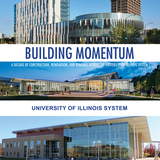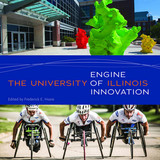Results by Title
3 books about University of Illinois (Urbana-Champaign campus)
3 books about University of Illinois (Urbana-Champaign campus)

Building Momentum
A Decade of Construction, Renovation, and Renewal across the University of Illinois System
University of Illinois. Foreword by Timothy J. Killeen
University of Illinois Press, 2023
A detailed look at the expansion and renewal taking place on the three U of I campuses
The University of Illinois System’s universities have undergone a dramatic transformation. This lavishly illustrated volume showcases the major capital projects and renovations dedicated to keeping facilities on the cutting edge while at the same time preserving history at the universities in Urbana-Champaign, Chicago, and Springfield. Fueled by an ambitious capital initiative launched in 2018, these essential and forward-looking changes include more than 500 projects valued at $4 billion over 10 years. The initiative harnesses a mix of innovative funding programs like public-private partnerships, thoughtful use of capital reserves and bonding authority, and generous state funding.
The University of Illinois System’s universities have undergone a dramatic transformation. This lavishly illustrated volume showcases the major capital projects and renovations dedicated to keeping facilities on the cutting edge while at the same time preserving history at the universities in Urbana-Champaign, Chicago, and Springfield. Fueled by an ambitious capital initiative launched in 2018, these essential and forward-looking changes include more than 500 projects valued at $4 billion over 10 years. The initiative harnesses a mix of innovative funding programs like public-private partnerships, thoughtful use of capital reserves and bonding authority, and generous state funding.
Covering completed and ongoing projects, Building Momentum offers a one- or two-page feature on each undertaking that covers its history and purpose while providing specific details about its unit, campus, architect, square footage or renovation size, budget, and LEED or other certifications. More than 100 architectural drawings and commissioned and historical photographs round out the descriptions.
[more]

The University of Illinois, 1894-1904
THE SHAPING OF THE UNIVERSITY
Winton U. Solberg
University of Illinois Press, 2000
The distinguished historian Winton U. Solberg presents a detailed case study of one institution's transformation into a modern American university.
The years 1894 to 1904 mark the stormy tenure of Andrew S. Draper as president of the University of Illinois. Draper, a successful superintendent of schools with no college or university experience and no credentials as a post-secondary administrator, presided over many crucial improvements in the university's physical plant, curricula, and other areas. However, he failed to infuse the university with a spirit of cohesion, and his term as president was fraught with conflict.
From his inauguration on, the autocratic Draper collided with deans and faculty who opposed both the substance of his changes and the manner in which he presented and implemented them.
This volume closely examines the Draper years from the perspectives of faculty, students, and administrators. Solberg outlines the administrative, faculty, staff, and physical infrastructure. He also reveals a vibrant and varied student life, including a whirl of social activities, literary societies, intercollegiate debate and athletics, hazing, religion, and increasingly prominent fraternities.
A sharply delineated and detailed picture of a university in transition, The University of Illinois, 1894-1904 traces the school's shift from an institution known primarily as a training ground for engineers to a full-fledged university poised to compete on the national level.
The years 1894 to 1904 mark the stormy tenure of Andrew S. Draper as president of the University of Illinois. Draper, a successful superintendent of schools with no college or university experience and no credentials as a post-secondary administrator, presided over many crucial improvements in the university's physical plant, curricula, and other areas. However, he failed to infuse the university with a spirit of cohesion, and his term as president was fraught with conflict.
From his inauguration on, the autocratic Draper collided with deans and faculty who opposed both the substance of his changes and the manner in which he presented and implemented them.
This volume closely examines the Draper years from the perspectives of faculty, students, and administrators. Solberg outlines the administrative, faculty, staff, and physical infrastructure. He also reveals a vibrant and varied student life, including a whirl of social activities, literary societies, intercollegiate debate and athletics, hazing, religion, and increasingly prominent fraternities.
A sharply delineated and detailed picture of a university in transition, The University of Illinois, 1894-1904 traces the school's shift from an institution known primarily as a training ground for engineers to a full-fledged university poised to compete on the national level.
[more]

The University of Illinois
Engine of Innovation
Edited by Frederick E. Hoxie
University of Illinois Press, 2017
The founding of the university in 1867 created a unique community in what had been a prairie. Within a few years, this creative mix of teachers and scholars produced innovations in agriculture, engineering and the arts that challenged old ideas and stimulated dynamic new industries. Projects ranging from the Mosaic web browser to the discovery of Archaea and pioneering triumphs in women's education and wheelchair accessibility have helped shape the university's mission into a double helix of innovation and real-world change. These essays explore the university's celebrated accomplishments and historic legacy, candidly assessing both its successes and its setbacks. Experts and students tell the eye-opening stories of campus legends and overlooked game-changers, of astonishing technical and social invention, of incubators of progress as diverse as the Beckman Institute and Ebertfest. Contributors: James R. Barrett, George O. Batzli, Claire Benjamin, Jeffrey D. Brawn, Jimena Canales, Stephanie A. Dick, Poshek Fu, Marcelo H. Garcia, Lillian Hoddeson, Harry Liebersohn, Claudia Lutz, Kathleen Mapes, Vicki McKinney, Elisa Miller, Robert Michael Morrissey, Bryan E. Norwood, Elizabeth H. Pleck, Leslie J. Reagan, Susan M. Rigdon, David Rosenboom, Katherine Skwarczek, Winton U. Solberg, Carol Spindel, William F. Tracy, and Joy Ann Williamson-Lott.
[more]
READERS
Browse our collection.
PUBLISHERS
See BiblioVault's publisher services.
STUDENT SERVICES
Files for college accessibility offices.
UChicago Accessibility Resources
home | accessibility | search | about | contact us
BiblioVault ® 2001 - 2024
The University of Chicago Press









